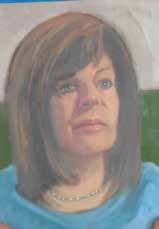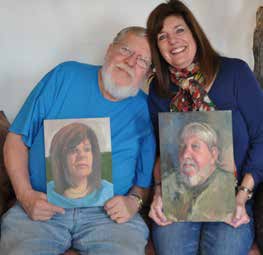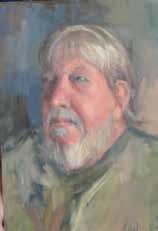What do you see when you look in the mirror? Maybe it’s an arched nose, bushy brows, your father’s eyes or crow’s feet. What would an artist see studying your face for two hours.
Nickel Plate Arts studio artists Lesley Haflich and John Reynolds recently turned their brushes on each other to paint a pair of beautiful realistic portraits.
John is no stranger to faces. He has painted more than 100 self-portraits and about 500 portraits of other people. While other artists find inspiration in vast landscapes or freeflowing abstract, he loves the close, intense study that portraiture requires.
“Everything about it is tough,” he says. “The proportions of the face are so many and so intricate.” While getting the right hair color and skin color is easy, John says it’s scale and being able to truly paint what you see that makes portraits the challenge that continues to excite him.



In our age of easy-to-take and easyto- trash digital photos, Lesley says portraits take on more importance and meaning in the art world. “It’s a permanent record of who a person is or was. When it’s on canvas and in a frame, it’s not going to be thrown away. It captures a point in time, but it’s also timeless,” she says.
Even when the person in the frame isn’t a relative, friend or icon, there is something to enjoy. Lesley is drawn to portraits of girls and women around ages 12-30. “It’s something in the eyes,” she says.
John calls his painting of Lesley an expression of how he sees her. She sat for him for two hours, a loose impressionistic style resulting. “My painting is pretty literal, but I can’t help but interject my impression of her as I’m painting. How I view the person will influence the end result,” he says.
“I like to show dimension in portraits, highlight certain areas and leave other areas areas softer, showing shadows and contours,” Lesley says. “On John’s portrait, since he has done a lot of self-portraits, I wanted to do one where he was to the side a bit, to get an angle he couldn’t get on his own.
I see John as a Renaissance man, showing his hair a little bit longer. He looks like a pioneer of yesterday.”
John and Lesley know each other well, which colored how they interpreted one another. Painting someone they don’t know is different. “I just paint what I see,” John says.
“When they can sit for me, I can get an idea of what they look like at different angles with different lighting. I look for something that we might want to exaggerate to bring out the characteristic of a person, like making the eyes slightly bigger.” Lesley takes a gentler approach, trying to make flattering paintings of a person by reducing wrinkles or softening a woman’s skin. With portraits of men, John might emphasize wrinkles to make them look more rugged.
As a patron commissioning an artist to paint a portrait, it’s important to tell the artist how you view the subject and how you feel about the person, especially if the artist is working from a photograph. If you must use a photo, choose a picture that most closely resembles the person — not necessarily the one that is most flattering. Or provide the artist with several photos so he or she can see the person in different light and at different angles.
“The face is so unique. You can paint a pear and say it’s a pear. But I can’t paint any face and say it’s a certain person. People are like snowflakes,” Lesley says.
To start a conversation about commissioning John or Lesley for a portrait, visit their websites: lesleyhaflichartist.com and johnreynoldsfineart.com.
Nickel Plate Arts cultivates arts resources to enrich the lives of everyone who experiences our community. A commitment to creativity, leadership, innovation, efficiency and individual dignity guides what we do and how we do it. Nickel Plate Arts serves eastern Hamilton County, from Fishers to Atlanta. To carry out our mission and spirit of collaboration, we also engage with neighboring cities and towns. Learn more at nickelplatearts.org, on Facebook, Twitter, and Instagram.

